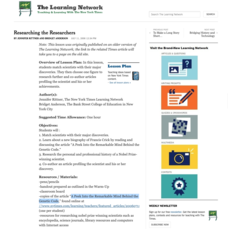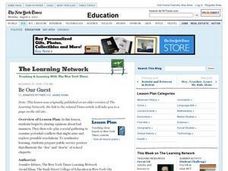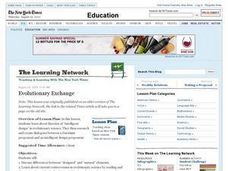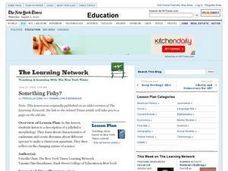Curated OER
Fruitful Questions
Learners examine a fruit-related Q & A Science Times article. They write their own food science questions and answer them in the same format as the article. For homework, they analyze their fruit consumption according to U.S....
Curated OER
Rat-ional Pet Concerns
Learners explore a recent salmonella outbreak in young students linked to pet rodents. They create pamphlets to help assist and inform pet owners about the disease and necessary health precautions.
Curated OER
Prescriptions for Disaster?
Students share opinions about prescription drugs and prepare public service campaigns to inform peers and adults about the dangers of prescription drug abuse. Their ads also offer prevention techniques and possible methods of treatment.
Curated OER
Explorers of the New World
Learners research explorers and explore how exploration affected the Western Hemisphere; students demonstrate competency in using multimedia encyclopedia and information software, and present PowerPoint presentation to class with two...
Curated OER
Crime Watch
Students analyze the recent rise of homicides in some American cities, create and share posters, and write reflective essays in the form of letters to community leaders.
Curated OER
Teen Angst
Students gain a broader understanding of new scientific research about the life cycle of the Tyrannosaur, and translate their knowledge into the creation of an illustrated studenT book produced and created by the entire class.
Curated OER
Design Your Dream Room
Students determine length, width, perimeter, and surface area, and work with two-dimensional representations of three-dimension objects to design and write descriptions of their dream bedrooms.
Curated OER
Bookmark It!
Students analyze piece of literature for symbolism and create a bookmark containing an illustration of the symbolism in it, a quote that shows the symbolism and an explanation of how this symbolism enhances the work.
The New York Times
Researching the Researchers
Students match scientists with their major discoveries, choose one figure to research further, and co-author articles profiling the scientist and his or her achievements.
Curated OER
Electric Blues
Students brainstorm a list of electrical devices used in their home. They read an article about electricity usage in a heat wave. In groups, they create public service announcements promoting energy conservation. They share their ideas...
Curated OER
A Tale of Two Wars
Students create Venn diagrams comparing and contrasting the Vietnam and Iraq wars. They write informed letters to their senators expressing their opinions and possible solutions to the war. They also create mock bumper stickers...
Curated OER
Alfred Hitchcock and David O. Selznick
Young scholars compare/contrast the Hollywood film industry of the 30s and 40s with Hollywood today. They watch a video on David O. Selznick and Alfred Hitchcock, conduct Internet research, and create a poster to present their findings.
Curated OER
Be Our Guest
Students share their own opinions about proper and poor etiquette in school. After reading an article, they discover matters of etiquette and conflict that occur during holiday rituals. They role-play the potential conflicts and...
Curated OER
Evolutionary Exchange
Students discuss the difference between designed and natural elements. After reading an article, they discover information about current controversies in evolutionary science. In groups, they research and write dialogues between two...
Curated OER
Something Fishy?
Learners try to draw and identify a jellyfish from a physical description. After reading an article, they discover new information about cnidarians. In groups, they research and develop dioramas about a specific cnidarian species. They...
Curated OER
Who Gives a Hoot?
Students look at owl migration and its impact on the environment and the food chain after reading an article from The New York Times. Students then apply this information to and research different food chain situations for other species...
Curated OER
Eyeing the Next Einstein
Students complete a KWL chart on Albert Einstein. After they read an article, they discover more about his iconic status and how future scientists view him. In groups, they create trading cards about Einstein and another scientist of...
Curated OER
Discoveries of Titanic Proportions
Students analyze various statements on the moon. After reading an article, they discuss the findings about a new moon around Saturn. In groups, they re-create a press conference in which the new findings were released to the public. ...
Curated OER
DNA-B-C's
Students review what they already know about DNA. After reading an article, they discover a new technique to map the course of evolution. In groups, they create ways to present this material to younger children and research DNA's uses.
Curated OER
A Site to See
Students identify the risks and benefits of living next to a volcano. After reading an article, they discuss the behaviors of an active volcano. Using the Internet, they work together to research volcano-monitoring techniques and create...
Curated OER
Science on the Skids
Students discuss the decline in the sciences in America by comparing statistics and information from the U.s. to other countries. Then they write and deliver a "State of the Sciences" address to their peers.
Curated OER
A Historic Gamble
Learners explore and evaluate the economic impact of legalized gambling on Native American Indian communities. They draft short, persuasive speeches that take the perspective of a tribal elder appearing at a town council meeting.
Curated OER
Navigating the Straits
Learners research the players and events that have influenced U.S.-China relations since World War II, with specific emphasis on the two countries' relationships with Taiwan. They write a briefing paper, advising the president on the...
Curated OER
Tangled Text
Students list different forms of communication, assess importance of writing, read and discuss article "String, and Knot, Theory of Inca Writing", research system of writing, and create "How It Works" posters.























